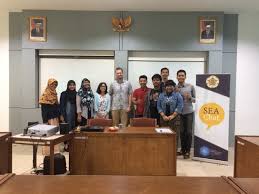
SEA Chat (Southeast Asian Chat) is the monthly agenda of Center for Southeast Asian Social Studies which invites students to discuss about countries in Southeast Asia region. It is expected to provide a clear picture of the state of the country, share information, and be a way to understand each other. On Monday (24/07/2017) at 15:00 at the CESASS Library, SEA Chat was again held for the fifth time. With the theme “Unstereotyping Southeast Asia”, this time SEA Chat invited Gibson Haynes, an American Southeast Asia researcher from John Hopkins University.
SEA Chat is always packed in relaxed talks about countries in Southeast Asia, as well as SEA Chat # 5 this time. Haynes as an American opened the conversation by telling about the stereotypes of outsiders, especially Americans about Southeast Asia. As a distant region, Americans sometimes can not distinguish between regional boundaries in Southeast Asia and sometimes even East Asia. They consider the inhabitants of the Asian continent to be the same ethnicity, usually identical with the Chinese. This is also confirmed by one of the participants who happened to have been to the United States and she felt how, as an Indonesian, sometimes people think of Indonesian, including her, as the same person with the Chinese.
Indeed, as a multicultural country, many immigrants come to the United States, including immigrants from Southeast Asia. This phenomenon is enough to give understanding to Americans about the ins and outs of Southeast Asians. Haynes recounted that there are quite a lot of Filipino and Cambodian communities in the United States. In addition, Haynes recounted that historical background also influences. Vietnam, one of the most important countries in the history of the war in the United States, became one of Southeast Asia’s most famous nations. While other countries that have never played a role in the history of the United States do not seem too imprint on the hearts of Americans.
Thus, Haynes argued that one of the most powerful ways to destereotype Southeast Asia in the present-day is exchange program in education that has been held quite often, both Americans to Southeast Asia, and Southeast Asians to the United States. He admitted that not a few students from Southeast Asia study in the campuses in the United States, as well as the teachers and lecturers from Southeast Asia who have career in college in the United States.
Discussion at SEA Chat # 5 was quite alive because the participants who were Southeast Asian activist students also seemed very interested in the theme and almost all discussed, asked questions, answered, and reciprocated, and of course shared experiences about this Southeast Asian stereotype from glasses of local residents. (Nitya)
